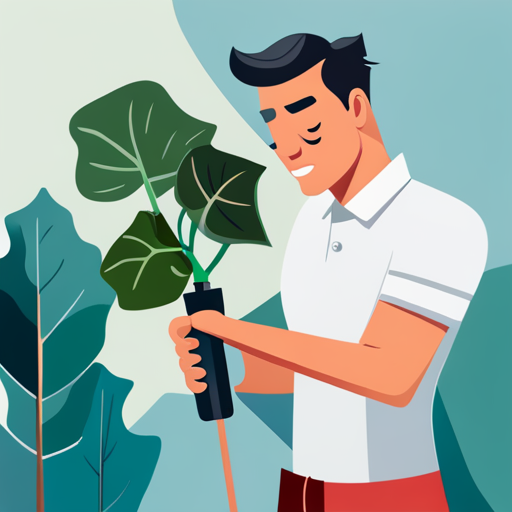Alocasia plants, popular for their striking foliage, can sometimes exhibit curled leaves, which can be concerning for plant owners. Understanding the causes behind this issue is crucial for effective treatment and prevention.
There are several factors that can contribute to leaf curling in Alocasia plants. Environmental stressors such as improper lighting, water shortage, or low humidity can lead to this problem. Nutrient deficiencies, particularly nitrogen, potassium, magnesium, and iron, can also cause leaf curling. Pests like mealybugs, scale insects, and spider mites are known to infest Alocasia plants and result in curled leaves. Additionally, diseases such as bacterial leaf spot, fungal leaf spot, and powdery mildew can also cause this issue.
This article will explore the possible causes of leaf curling in Alocasia plants, provide treatment options, and offer tips for prevention and maintenance. By understanding and addressing these factors, plant owners can ensure the health and vitality of their Alocasia plants.
Contents
- 1 Our Highlighted Points
- 2 Possible Causes
- 3 Treatment Options
- 4 Prevention and Maintenance
- 5 Frequently Asked Questions
- 5.1 How often should I water my Alocasia plant?
- 5.2 Can I use regular household insect spray to get rid of pests on my Alocasia leaves?
- 5.3 Can I use fertilizer to correct nutrient deficiencies in my Alocasia plant?
- 5.4 Is it normal for Alocasia leaves to naturally curl?
- 5.5 Can I propagate my Alocasia plant to prevent leaf curling?
Our Highlighted Points
- Low water or humidity can cause Alocasia leaves to curl inward.
- Alocasia leaf curling can be caused by factors such as sun exposure, water shortage, nutrient deficiencies, pests, and diseases.
- Proper watering, lighting, and humidity levels are essential for preventing leaf curling in Alocasia plants.
– Prompt action should be taken to address pest infestations and diseases to save Alocasia plants.
Possible Causes

Possible causes of Alocasia leaf curling, as previously mentioned, include low water or humidity, sun exposure, water shortage, nutrient deficiencies, pests, and diseases.
Low water or humidity levels can lead to dehydration of the plant, causing the leaves to curl inward.
Sun exposure, especially intense or direct sunlight, can also cause leaf curling.
Water shortage, either from underwatering or improper watering techniques, can result in leaf curling.
Nutrient deficiencies, such as nitrogen, potassium, magnesium, or iron, can hinder proper leaf development and cause curling.
Pests like mealybugs, scale insects, and spider mites can infest the plant, leading to leaf curling.
Lastly, diseases such as bacterial leaf spot, fungal leaf spot, and powdery mildew can cause yellowing and curling of the leaves.
Potential solutions include ensuring adequate water and humidity levels, providing shade or filtered sunlight, addressing nutrient deficiencies through fertilization, and treating pest or disease infestations promptly.
Common nutrient deficiencies should be addressed by providing appropriate fertilizers or amending the soil with necessary nutrients.
Treatment Options

Treatment options for addressing the issue of Alocasia leaf curling include adjusting environmental conditions such as light, water, and humidity levels, addressing nutrient deficiencies, and addressing any pest or disease infestations. When it comes to environmental conditions, providing the plant with adequate light, avoiding overexposure to sunlight, and increasing humidity through methods like misting can help prevent leaf curling. Nutrient deficiencies can be addressed by using fertilizers specifically formulated for Alocasia plants, ensuring they receive sufficient nitrogen, potassium, magnesium, and iron. In case of pest infestations, natural remedies such as insecticidal soap or neem oil can be applied to the undersides of leaves. However, if the issue persists or becomes severe, professional intervention may be necessary to diagnose and treat any underlying diseases or infestations.
| Treatment Options | Description |
|---|---|
| Adjust environmental conditions | Provide adequate light, avoid overexposure to sunlight, increase humidity |
| Address nutrient deficiencies | Use fertilizers with nitrogen, potassium, magnesium, and iron |
| Address pest infestations | Apply natural remedies such as insecticidal soap or neem oil |
| Professional intervention | Seek professional help for severe or persistent issues |
Prevention and Maintenance

Prevention and maintenance strategies can help maintain optimal conditions for healthy growth and minimize the risk of leaf curling in Alocasia plants. To ensure proper leaf care, it is important to avoid common mistakes that can contribute to leaf curling.
Firstly, it is crucial to avoid overwatering the plant. Alocasia plants prefer slightly moist soil, so allowing the top inch of soil to dry out before watering is recommended.
Additionally, providing proper lighting is essential. Alocasia plants thrive in bright, indirect light, but direct sunlight can cause their leaves to curl.
Increasing humidity levels by misting the leaves or using a humidifier can also help prevent leaf curling.
Lastly, repotting the plant into a larger pot with fresh soil can prevent cramped roots and promote healthy growth.
By following these leaf care tips and avoiding common mistakes, Alocasia plants can maintain their beautiful foliage without experiencing curling leaves.
You may also like to read the causes of caladium leaf curling and guidance on prevention and care.
Frequently Asked Questions
How often should I water my Alocasia plant?
The watering frequency for Alocasia plants depends on various factors such as environmental conditions, pot size, and soil type. Signs of overwatering include yellowing leaves, root rot, and wilting.
Can I use regular household insect spray to get rid of pests on my Alocasia leaves?
Regular household insect spray may not be effective in controlling pests on Alocasia leaves. It is recommended to use organic methods such as insecticidal soap or neem oil. Temperature fluctuations can contribute to leaf curling in Alocasia plants.
Can I use fertilizer to correct nutrient deficiencies in my Alocasia plant?
Using organic fertilizers can help correct nutrient deficiencies in Alocasia plants. However, it is important to note that proper watering is crucial for their health and growth. Both factors play a significant role in maintaining the well-being of Alocasia plants.
Is it normal for Alocasia leaves to naturally curl?
Underwatering can cause Alocasia leaf curling. To prevent leaf curling, ensure proper watering by allowing the top inch of soil to dry out before watering. Increase humidity by misting leaves and provide adequate lighting.
Can I propagate my Alocasia plant to prevent leaf curling?
Propagation methods such as division or stem cuttings can be used to propagate Alocasia plants. However, propagation alone may not prevent leaf curling. Proper care, including adequate water, light, and humidity, is necessary to prevent leaf curling in Alocasia plants.

